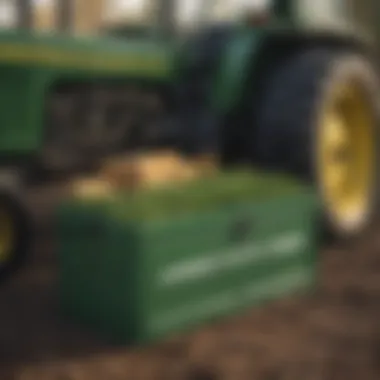Understanding the John Deere Triangle Tool Box


Intro
The John Deere Triangle Tool Box represents a significant advancement in agricultural tools. This section lays the foundation for understanding its importance. Known for its durability and innovative design, the Triangle Tool Box serves as a practical asset for farmers and agricultural enthusiasts alike. In this article, we will dissect its features, advantages, and historical context, focusing primarily on how it complements modern farming practices.
Key Concepts and Terminology
Basic Definitions
Historical Context
The John Deere Company has a rich history dating back to the early 19th century. The company originally focused on providing plows to farmers. Over the years, it expanded its product line to include a variety of tools and machinery. The introduction of the Triangle Tool Box emerged as a response to the needs of farmers for enhanced tool organization. Understanding this evolution is crucial in appreciating the significance of the Triangle Tool Box in modern agriculture.
Recent Innovations and Trends
Technological Advancements
In recent years, technological advancements have greatly influenced agricultural tools. The Triangle Tool Box has embraced these changes, incorporating features such as modular storage and weather resistance. These innovations ensure that tools are not only organized, but also protected against the elements.
Sustainable Practices
Sustainability is increasingly becoming a key focus in agriculture. The John Deere Triangle Tool Box supports sustainable practices by promoting efficient organization, which can reduce waste. By having tools readily available, farmers spend less time searching and more time applying their expertise in the field.
Practical Applications and Techniques
Step-by-step Guides
- Assess Your Needs: Determine the type and number of tools you will store.
- Organize by Frequency of Use: Keep frequently used tools at the top or in easy-to-reach locations.
- Label Sections: Clearly label compartments for easy identification.
- Regular Maintenance: Periodically check for wear and tear on tools.
Case Studies
Many farmers have reported increased efficiency after utilizing the Triangle Tool Box. For example, John Smith, a farmer from Ohio, experienced a notable reduction in the time spent gathering tools. His organized approach not only improved productivity but also allowed him to focus more on strategic farming decisions.
Efficient tool organization leads to enhanced productivity in farming.
By understanding the principles behind the John Deere Triangle Tool Box, farmers can make informed decisions that align with their operational goals. This article aims to provide a comprehensive view, enhancing the reader's grasp of this crucial tool within agriculture.
Preface to the John Deere Triangle Tool Box
The introduction to the John Deere Triangle Tool Box is crucial. This tool box embodies efficient design and functionality tailored for agricultural needs. Farmers often face challenges regarding tool organization and access during critical tasks. The Triangle Tool Box addresses these concerns effectively by offering a structured solution for tool management. Its design not only emphasizes accessibility but also enhances productivity in the field. Understanding this tool box will help users appreciate its role in modern agriculture.
Overview of John Deere as a Brand
John Deere stands as a pillar in the agricultural equipment industry. Founded in 1837, John Deere has a long history of innovation and quality in manufacturing. The brand is synonymous with reliability and performance in farming tools and machinery. Over the years, John Deere has consistently invested in research and development, aiming to enhance the productivity of farmers across the world. Their commitment to durable products includes a diverse range of tools, with the Triangle Tool Box being a significant addition.
Significance of Tool Boxes in Agriculture
Tool boxes play an important role in agriculture. Farmers require a variety of tools to manage tasks effectively. Without proper organization, it can become difficult to locate and access necessary tools in a timely manner. A tool box like the John Deere Triangle Tool Box provides a practical solution for this problem. It offers features that facilitate orderly storage and quick accessibility. This helps in minimizing downtime, which is crucial during busy farming seasons. In essence, tool boxes enhance working efficiency and contribute to better agricultural outcomes.
Historical Context of the Triangle Tool Box
In exploring the John Deere Triangle Tool Box, understanding its historical context provides valuable insight into its significance and evolution. This context reveals the broader trends in agricultural tools and the innovative responses to farmers' needs over time. Through examining the evolution of agricultural tools alongside the specific development of John Deere's offerings, we can appreciate how this tool box fits within a larger narrative of agricultural efficiency and productivity.
Evolution of Agricultural Tools


Agricultural tools have undergone significant changes since the dawn of farming. From simple hand tools to advanced mechanized equipment, each era introduced innovations that aimed to enhance productivity. Initially, farmers relied on basic implements like hoes and plows, crafted from wood or stone. These early tools were often labor-intensive and limited in functionality.
As farming techniques progressed, so did the tools. The Industrial Revolution marked a turning point with the introduction of metal tools and machinery. This period saw the emergence of more efficient devices, such as the seed drill and the mechanical reaper. Each invention addressed specific challenges faced by farmers, increasing efficiency and reducing manual labor.
The late 20th century and early 21st century witnessed a further revolution with the incorporation of technology in farming. The shift towards precision agriculture introduced sophisticated tools aimed at optimization, including GPS-guided equipment and data analysis software. This evolution mirrors a focus on improving crop yield and sustainability, highlighting the importance of well-designed tools in modern farming.
The Development of John Deere Tool Boxes
John Deere, founded in 1837, has long been a pioneer in agricultural manufacturing. The brand established its reputation by providing durable, reliable equipment. The development of John Deere tool boxes is a testament to their commitment to quality and innovation.
The Triangle Tool Box, in particular, emerged in response to the increasing complexity of farming tasks. As farmers began using a wider array of tools and equipment, the necessity for efficient storage grew. John Deere recognized this need and designed the Triangle Tool Box to provide a practical, organized solution for tool management.
The design itself reflects careful consideration of farmers' requirements. Its shape and configuration are not merely aesthetic; they enhance accessibility and usability. All these factors make it a relevant addition to any farming operation, indicating how John Deere continues to shape tool design while responding to modern agricultural demands.
In summary, the historical context of the Triangle Tool Box is crucial for understanding its importance within agricultural practices. The evolution of agricultural tools sets the stage for innovations that John Deere brought to market, including their tool boxes. These developments highlight a continuous response to the ever-changing landscape of farming, emphasizing the significance of efficient tool management in enhancing productivity.
Technical Specifications
Understanding the technical specifications of the John Deere Triangle Tool Box is essential for discerning its capabilities and suitability for various agricultural tasks. The specifications highlight how this tool box aligns with the demands of farmers and enhances efficiency in their daily operations. Key elements such as design features and functional components come into play, providing valuable insights into how these features benefit users.
Design Features
Dimensions
The dimensions of the John Deere Triangle Tool Box are critical as they directly influence its portability and ease of use. Typically, the tool box is engineered to be compact, allowing for seamless integration into different farming vehicles, whether tractors or pickup trucks. This compactness makes it a preferred choice among farmers who require mobility without sacrificing storage capabilities. Additionally, the design often enables stacking or fitting into tight spaces, optimizing the use of available room. One unique aspect is the triangular shape, which inherently offers stability while maximizing storage capacity even in constrained environments.
Materials Used
The materials used in the construction of the John Deere Triangle Tool Box play a significant role in its durability and overall performance. Commonly made from high-quality steel or heavy-duty plastic, these materials ensure the tool box withstands harsh farming conditions. The choice of material is beneficial because it delivers an optimal balance of weight and strength. For instance, steel offers robust protection against impacts, while weather-resistant plastics prevent corrosion from exposure to the elements. However, understanding specific applications of materials will guide farmers in making informed decisions that align with their operational context.
Weight Capacity
The weight capacity of the Triangle Tool Box dictates how much equipment and tools it can safely carry. John Deere designs their tool boxes to support substantial weight, which is crucial for those needing to transport multiple tools in one trip. A key characteristic is the reinforcement within the structure, which aids in maintaining integrity even when loaded. Having a high weight capacity ensures that the farmers do not have to make frequent trips for tools, thus enhancing productivity. Nevertheless, users must remain cautious of not exceeding specified limits to avoid damaging the tool box.
Functional Components
Storage Compartments
Storage compartments are central to the functionality of the John Deere Triangle Tool Box. Such compartments offer designated spaces for various tools and equipment, promoting organization. The layout of these compartments is deliberately designed, allowing for efficient use of space while making tools easy to locate. A distinctive feature is the available customization options, including removable dividers to tailor the storage to individual needs. This adaptability is a significant advantage, catering to the diverse tool sets used in agricultural work environments.
Tool Organization
Effective tool organization within the Triangle Tool Box is essential to facilitate quick access to items. Various organizational elements, such as tool racks and holders, help structure the storage in a way that minimizes clutter and maximizes usability. A notable feature is the inclusion of slots for specific types of tools, such as wrenches or screwdrivers, ensuring each item has its rightful place. This systematic arrangement makes it easier for users to find what they need during critical times without wasting time.
Accessibility Features
Accessibility features of the John Deere Triangle Tool Box enhance user experience by making it easier to reach tools and equipment. The design typically incorporates wide openings or hatch styles, allowing for quick access to contents. Moreover, ergonomic handles may be included to improve lifting efficiency. These features hold tangible benefits for those working in the field, as ease of access directly ties into the efficiency of work processes. However, certain designs may require users to adhere to specific loading techniques to capitalize on these features fully.
Practical Applications
The practical applications of the John Deere Triangle Tool Box are vital for understanding its role in the agricultural sector. This section focuses on how farmers utilize this tool box across different farming techniques. It emphasizes the efficiency gains and organizational benefits provided by the triangle design.
Usage in Various Farming Techniques
The John Deere Triangle Tool Box is designed to meet the needs of diverse farming practices. Whether in crop production, livestock management, or landscaping, this tool box offers a solution.


- Crop Production: Farmers often use the tool box to store hand tools like hoes, pruners, and seeders. Keeping these tools organized reduces time spent searching for them, allowing farmers to focus on planting and harvesting.
- Livestock Management: For those managing livestock, the tool box can hold essential tools such as fencing supplies, veterinary instruments, and feeding equipment. Accessibility to these tools translates to increased productivity in caring for animals.
- Landscaping and General Maintenance: Landscapers also benefit from the tool box. It can house gardening tools and supplies needed for maintaining crops, allowing quick access and minimizing downtime in the field.
Understanding these applications helps to recognize the versatility and importance of the John Deere Triangle Tool Box in everyday farming operations.
Benefits to Agricultural Productivity
The incorporation of the Triangle Tool Box into agricultural practices offers several productivity benefits that can significantly impact farmers' day-to-day operations. These advantages stem from its ergonomic design and efficient use of space.
- Time Efficiency: By allowing farmers to keep tools organized and within easy reach, the triangle tool box greatly reduces the time lost searching for misplaced equipment.
- Enhanced Organization: The divided compartments within the tool box facilitate better organization. Each tool has a designated spot, reducing the chaos that often accompanies manual labor on farms.
- Weight Distribution: The triangle shape of the box allows for better weight distribution, making it easier to transport tools around the farm.
- Durability: Constructed with high-quality materials, the tool box withstands tough farming conditions. Its resilience contributes to the longevity of the tools stored inside, ultimately saving farmers money over time.
The John Deere Triangle Tool Box represents not just a storage solution, but a strategic asset for optimizing agricultural workflow and improving productivity.
These benefits underscore how a simple piece of equipment can contribute profoundly to the efficiency and effectiveness of farming operations, making the Triangle Tool Box an indispensable tool for modern agriculture.
Comparative Analysis
The comparative analysis of the John Deere Triangle Tool Box is essential in understanding its unique position within the agricultural tools market. This section helps in assessing its features, benefits, and practicality compared to other tool boxes. Knowing how it stands against its competitors provides clarity and insight for potential buyers and users within the farming community. Furthermore, this analysis aids in discerning the merits of the triangle design, which is distinct in its form and function.
Comparison with Other Tool Boxes
When comparing the John Deere Triangle Tool Box to other tool boxes available in the market, several key aspects come into play. Other brands, such as Craftsman and Husky, offer versatile tool storage solutions too. However, the Triangle Tool Box has features that offer specific advantages tailored to agricultural needs:
- Space Optimization: The triangular shape allows for more streamlined storage, easily fitting into various spaces in a vehicle or farm implement.
- Durability: Built with high-quality materials, the John Deere model often outlasts standard boxes from other brands which may use cheaper materials.
- Organizational Capabilities: It supports enhanced organization through its various compartments designed for farm tools specifically.
This comparison indicates that while there are many options, the John Deere Triangle Tool Box addresses specific needs within agriculture that others may not fulfill as effectively.
Advantages of the Triangle Design
The advantages of the triangle design in the John Deere Triangle Tool Box are multifold. This particular shape is not just an aesthetic choice but a functional one:
- Stability: The lower center of gravity provided by the triangular shape adds stability when stored or transported, reducing the risk of tipping.
- Accessibility: The design promotes easier access to tools, especially in tight spaces, thanks to its angles and layout.
- Weight Distribution: It ensures that heavier tools remain closer to the base, making it easier to carry and handle.
Maintenance and Care
Maintaining and caring for the John Deere Triangle Tool Box is crucial for ensuring its longevity and optimal functionality. Regular maintenance not only preserves the structural integrity of the toolbox but also enhances its usability in various agricultural tasks. When farmers and enthusiasts invest in this tool, understanding its upkeep can lead to improved efficiency and reduced replacement costs.
Regular Maintenance Practices
One of the most effective ways to ensure the longevity of the John Deere Triangle Tool Box is through routine maintenance. This encompasses several practices that can be done easily:
- Cleaning: Regularly remove dirt, mud, and debris. Use a soft cloth or sponge with mild soap and water. Avoid harsh chemicals that may corrode surfaces.
- Inspection: Frequently check for any signs of wear, such as dents, scratches, or rust. Early detection of issues can prevent more significant problems down the line.
- Lubrication: Apply lubricant to moving parts like hinges and locks. This will ensure smooth operation and prevent rust accumulation.
- Proper Storage: Store the toolbox in a dry place, away from direct sunlight. This helps in reducing exposure to moisture and extreme temperatures, which can lead to material degradation.
By establishing these simple routines, farmers can maximize the effectiveness of their toolbox.
Troubleshooting Common Issues
Even with regular maintenance, issues may arise with the John Deere Triangle Tool Box. Knowing how to troubleshoot these problems can save time and frustration in the field. Here are some common issues and their solutions:
- Rust Formation: If rust appears, sand it down to the bare metal and treat it with a rust-inhibiting primer and paint. Regular preventive cleaning can reduce this risk.
- Hinge Problems: If the hinge is stiff or not closing properly, apply lubricant to ensure easy movement. If it remains problematic, consider replacing the hinge.
- Lock Malfunction: If the lock becomes jammed, try a penetrating lubricant to loosen it. For persistent issues, replacing the lock may be necessary.
In summary, maintaining the John Deere Triangle Tool Box is essential for keeping it functional and efficient. Regular cleaning, inspections, and proper troubleshooting can go a long way in enhancing its lifespan.
Understanding and practicing maintenance and care will ultimately lead to significant benefits. It ensures that the toolbox is always ready for use, which is vital in the demanding agricultural environment.


User Experiences and Case Studies
User experiences and case studies are fundamental in understanding the impact of the John Deere Triangle Tool Box. These narratives provide real-world insights into how the tool box performs under various conditions. They reveal its efficacy, strengths, and any weaknesses in practical applications. When farmers share their stories, it highlights not only the utility of the tool but also its adaptability to different farming techniques. This section will examine testimonials from farmers and innovative uses of the Triangle Tool Box in the field, offering a deeper perspective into its importance in agriculture.
Testimonials from Farmers
Farmers worldwide provide invaluable feedback on the Triangle Tool Box. Many highlight its robustness, stating that the design provides ample storage while being easy to transport. For instance, a farmer from Nebraska noted, "Having a durable and spacious tool box like this means I can take all essential equipment without worrying about space. It has improved my efficiency significantly." Such testimonials underscore the critical role the Triangle Tool Box plays in day-to-day farming activities.
Additionally, farmers appreciate specific features that contribute to ease of use. One user from Iowa remarked on the clever organization system that the box offers, saying, "I can find my tools quickly, which saves time during critical planting and harvesting periods." These experiences illustrate the box's practical benefits and reinforce its value in enhancing productivity on the farm.
Innovative Uses in the Field
The adaptability of the John Deere Triangle Tool Box extends far beyond traditional uses. Many farmers have discovered innovative applications, maximizing its functionality. For example, some have repurposed the tool box as a mobile workshop, allowing them to conduct repairs right in the field. This approach minimizes downtime, which is crucial during peak seasons.
Other farmers have integrated the Triangle Tool Box into more specific agricultural operations. In vineyard management, a farmer utilizes it to store pruning tools and maintenance equipment, thereby keeping them organized and accessible. The ability to customize the tool box to specific needs highlights its versatility in varied agricultural contexts.
Moreover, local agricultural workshops have started to incorporate case studies involving the Triangle Tool Box, demonstrating its innovative uses. These workshops showcase the tool box's effectiveness in diverse farming practices, promoting knowledge-sharing among farmers.
"The John Deere Triangle Tool Box is not just a storage solution; it's a critical component that allows farmers to implement their strategies effectively."
By analyzing these user experiences and case studies, one can see the broader implications of the Triangle Tool Box's design and functionality. It is more than just a product; it is an important asset in modern agriculture.
Future Prospects
The future of the John Deere Triangle Tool Box and similar agricultural implements is closely linked to emerging trends in farming and advancements in technology. Understanding these prospects is crucial for farmers and enthusiasts looking to optimize productivity and efficiency in their operations. The Triangle Tool Box is not just a practical storage solution; it represents a convergence of design innovation and technological integration that can redefine effectiveness in the field.
Trends in Agricultural Tool Design
The agricultural landscape is transforming, and so are the tools used within it. Recent trends indicate a shift towards more ergonomic and multifunctional designs. The focus is not only on functionality but also on the ease of use. Modern tool boxes are evolving to offer features that meet the changing demands of agricultural tasks. Key trends include:
- Compact Structures: There is a move towards tool boxes that provide maximum storage in minimized spaces. This helps farmers maximize their vehicle's capacity without sacrificing usability.
- Modular Designs: Farmers increasingly prefer tools that can be customized or adapted for specific tasks. This flexibility allows for better storage solutions based on individual preferences and work requirements.
- Sustainability: Environmentally friendly materials are becoming more prominent in tool design. Farmers are looking for durable products that also lessen the environmental impact.
The Triangle Tool Box embodies some of these trends with its clever design choices, making it a relevant choice for a diverse range of farming techniques.
Role of Technology in Enhancing Functionality
As technology continues to advance, the integration of smart features in agricultural tools is becoming essential. This can enhance the efficiency and ease of use of tools like the Triangle Tool Box. Here are some ways technology can play a role:
- Digital Organization: Features like QR codes or RFID tags for inventory management can be incorporated. This allows users to track tools and organize them better.
- Weather Resistance: Smart materials that react to temperature changes can keep the tools stored within protected.
- Automated Maintenance Alerts: As tools age, alerts can be programmed to remind the user of maintenance schedules, ensuring longevity and optimal performance.
The potential for innovation is significant.
"The integration of new technologies in the Triangle Tool Box can transform traditional agricultural practices, leading to increased efficiency and improved farmer satisfaction."
Closure
In the context of the John Deere Triangle Tool Box, the conclusion serves to reinforce the significance of its design and functionality in modern agriculture. This article has detailed various aspects of the tool box, from its construction to its practical uses. Understanding these elements is crucial as they highlight its role in ensuring productivity and efficiency among farmers.
Recapitulation of Key Points
The Triangle Tool Box, crafted by John Deere, is not merely a storage unit. Instead, it represents a blend of thoughtful design and practical application. Here are the key points discussed:
- Historical Background: The evolution of agricultural tools set the foundation for the Triangle Tool Box, showcasing its reliability.
- Design and Technical Specifications: Its dimensions and materials are chosen to maximize durability and ease of use.
- Functionality: Various compartments score high on organization, facilitating quick access to tools essential for day-to-day operations.
- User Experiences: Testimonials from farmers illustrate how this tool box transforms their workflow, enhancing productivity.
- Future Prospects: Trends indicate continued innovation in agricultural tools, with technology shaping the future of such designs.
By revisiting these points, we emphasize the Triangle Tool Box's contribution to effective agricultural practices.
Final Thoughts on the Triangle Tool Box
The John Deere Triangle Tool Box is more than a simple accessory for farming. Its design and functionality exemplify the efforts to make agricultural tasks smoother and more efficient. Form and function work together within its structure, allowing farmers to rely on it for their daily needs.
As agriculture continues to evolve, tools like this one will remain invaluable. They offer tangible benefits, enabling higher levels of organization and accessibility. Farmers seeking to improve their productivity can benefit significantly from understanding and utilizing this tool box effectively.















